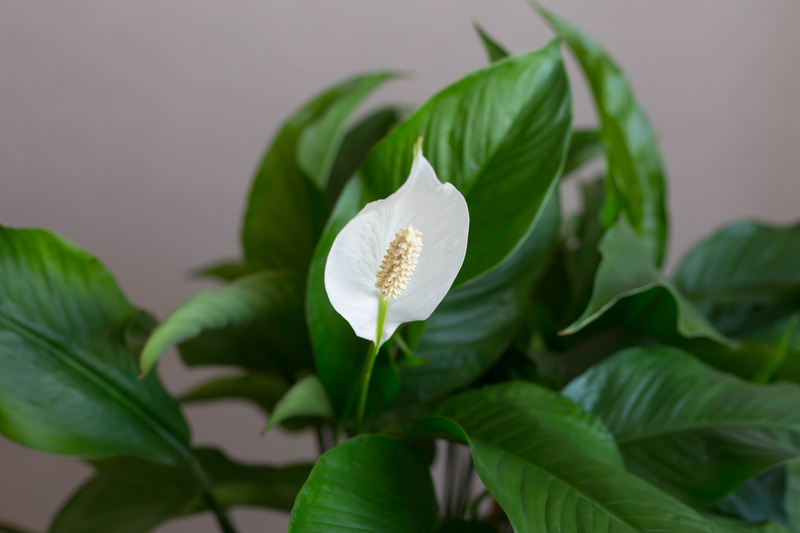Chasing Peace: Harmonious Zen Garden Arrangements
Posted on 13/08/2025
Chasing Peace: Harmonious Zen Garden Arrangements
In our modern, bustling lives, the pursuit of peace and tranquility feels increasingly elusive. Yet, the ancient art of Zen garden arrangements offers a pathway to serenity--not only as an aesthetic choice but as a life philosophy. Creating a harmonious Zen garden arrangement invites mindfulness, calmness, and a deep connection to nature right into your living space.

The Essence of Zen Gardens: A Brief History
The concept of Zen gardens--or Karesansui in Japanese--dates back to the 8th century, rooted deeply in Buddhist practice and the principles of Zen. These gardens are not merely decorative; they represent landscapes meticulously composed to evoke contemplation, meditation, and balance.
Traditionally, harmonious Zen garden designs use minimal elements like stones, gravel, moss, and pruned trees, all of which symbolize natural features such as mountains, rivers, and islands. Their simplicity encourages the mind to quiet, helping practitioners and visitors alike to chase inner peace.
Key Principles of Zen Garden Arrangement
- Simplicity (Kanso): Zen gardens express beauty through minimalism, removing non-essential elements.
- Naturalness (Shizen): Each feature mimics nature's flow, representing organic forms despite being manmade.
- Balance and Asymmetry: Rather than strict symmetry, Zen gardens favor asymmetrical arrangements to mirror nature's unpredictability.
- Symbolism: Rocks, sand, and plants are more than decorative; they symbolize islands, rivers, sea, or mountains, telling visual stories.
- Tranquility: The entire arrangement's purpose is to soothe the senses and promote mindful meditation.
Elements of a Harmonious Zen Garden Arrangement
To create a harmonious Zen garden, it's essential to understand the components and their symbolic meanings. Incorporating these core elements in a balanced manner creates a sanctuary for peace and reflection.
1. Rocks and Stones: The Garden's Backbone
Rocks represent mountains, islands, or animals. Their placement is never random; instead, each is thoughtfully positioned to encourage contemplation. Use contrasting sizes, placing larger stones as focal points and smaller ones as supporting features. Sometimes stones are grouped in odd numbers--often three--to align with Zen's embrace of natural irregularity.
2. Sand and Gravel: Artful Simplicity
Sand and gravel are the "seas" or "rivers" in Zen garden design. Raked patterns--waves, swirls, or concentric circles--symbolize water's movement, inviting the mind to flow unhindered. Raking these patterns can be a deeply meditative practice, perfect for those chasing peace in daily routines.
3. Moss and Ground Covers
Moss signifies age and stability. It softens the sharpness of stones, providing lush green patches that anchor the garden in tranquility. Moss is ideal for shaded spots, but other ground covers like creeping thyme or Irish moss can substitute in sunnier climates.
4. Plants and Shrubs: Subtle Vitality
While traditional Zen arrangements minimize floral displays, specific evergreens, maples, bamboo, or dwarf pine trees add depth and delicacy. Prune heavily to maintain their shapes and avoid chaos. This method, known as "niwaki," is a horticultural art in itself, reflecting patience and intention.
5. Water Features
Classic dry Zen gardens (Karesansui) do not use actual water, but in larger arrangements, you might see tranquil ponds or simple stone basins (tsukubai). Soft trickles or rippling waters promote an immersive peaceful ambiance.
6. Bridges, Lanterns, and Ornaments
Stone lanterns and understated wooden bridges provide both practical and decorative features, reinforcing the garden's spiritual and cultural links. Choose simple designs to prevent distractions from the garden's intrinsic calmness.
Design Techniques for Harmonious Zen Gardens
Creating a Zen garden--whether in a tiny courtyard or a grand landscape--demands intention and artistry. Here are expert tips for achieving true harmony in your Zen garden arrangement:
Strategic Placement
- Focal Points: Select one to two standout features (like a large stone or a pruned pine) as the heart of the arrangement.
- Asymmetry: Avoid centering elements. Embrace off-balance layouts to create visual intrigue and natural flow.
- Framing Views: Use plants or screens to frame "scenes" within your garden; each view should tell its own serene story.
- Layering: Place taller elements at the back, with stones or shrubs commanding the middle ground and ground cover in the foreground.
Choosing the Right Materials
- Natural Stones: Source locally if possible, seeking weathered stones with texture and character to evoke age and authenticity.
- Consistent Gravel: Select gravel with a uniform color and size for smoother raking patterns and cohesiveness.
- Sustainable Plants: Choose drought-resistant, slow-growing species. Minimal maintenance is best for preserving Zen-like peace.
Scale and Proportion
- Let each element relate in size and weight to its neighbors; avoid overcrowding, preserving negative space for a peaceful, open sensation.
- Tiny urban gardens can be equally powerful by focusing on miniature features that tell a complete story in small spaces.
Symbolic Pathways
Paths in Zen gardens often meander, encouraging slow, mindful walks. Simple stepping stones or gravel lanes offer invitation for reflection as visitors traverse the tranquil landscape.
Types of Harmonious Zen Gardens
Zen gardens come in several forms, each catering to unique needs and spaces. Here are some popular types to consider as you embark on chasing peace in your environment:
1. Karesansui (Dry Garden)
The classic dry landscape garden, composed of rocks and raked gravel, focuses solely on abstraction and symbolism. This type is perfect for patios or courtyards and is most associated with meditative Zen practice.
2. Tsubo-niwa (Courtyard Garden)
Designed for compact city homes, these pocket-sized gardens use minimalist plantings, lanterns, and moss to create a peaceful haven in limited space.
3. Roji (Tea Garden)
Originally created as pathways to teahouses, Roji gardens emphasize rustic purity, featuring stepping stones, bamboo fences, and water basins. They encourage calm, reflective walks leading to the tea ceremony--a ritual of harmony.
4. Strolling Gardens
With winding paths around ponds and arranged vistas, these gardens blend Zen philosophy with broader landscape design, suitable for large parks or estates.
Benefits of a Zen Garden for Mind and Body
Beyond their remarkable beauty, harmonious Zen gardens deliver profound psychological and physical benefits. If you are chasing peace for your inner and outer worlds, consider these advantages:
- Stress Reduction: Studies show that natural, minimalist spaces lower cortisol and blood pressure, reducing anxiety and improving mental clarity.
- Encourages Mindfulness: The repetitive actions of raking gravel or pruning shrubs ground you in the present moment.
- Creative Outlet: Designing and maintaining a Zen arrangement offers a unique canvas for calm self-expression.
- Connection to Nature: Even compact Zen gardens bring wildlife, seasonal changes, and fresh air to urban lifestyles.
- Personal Sanctuary: A well-crafted Zen garden becomes a private space for meditation, reading, or simple quiet reflection.
Cultivating Your Own Harmonious Zen Garden
Step-by-Step Guide
Ready to create your own Zen-inspired haven? Here's a practical plan:
- Choose the Location: Select a quiet area that receives partial sunlight and can be separated from chaotic surroundings.
- Clear the Space: Remove weeds, debris, and other distractions. Level the area for an even start.
- Design the Layout: Sketch your garden's shape, noting where rocks, gravel beds, and any plants will sit.
- Add Borders: Use wood, stone, or bamboo edging to define the garden area.
- Place Large Elements: Install focal stones, lanterns, or trees first, honoring traditional asymmetry and intent.
- Fill with Gravel or Sand: Spread evenly, then use a rake to craft calming patterns.
- Incorporate Plants: Add moss, low shrubs, or a single Bonsai for gentle green touches.
- Install Ornaments: Choose a simple water feature or bamboo fountain if desired.
- Final Touches: Stand back and review--adjust any items to enhance harmony and balance.
Seasonal Maintenance Tips
- Autumn: Sweep and rake regularly to remove fallen leaves while refreshing gravel patterns.
- Winter: Prune shrubs and trees, and check for stone and gravel shifting during freezes.
- Spring: Remove debris, reseed moss patches, and inspect water features for algae or blockages.
- Summer: Water moss and plants in the early morning to prevent evaporation.
Modern Zen Gardens: Adaptations for Contemporary Living
Today's fast-paced lifestyle means traditional Zen gardens must adapt. Many homeowners and designers have innovated to bring Zen principles indoors and into smaller urban settings.
- Tabletop Zen Gardens: Miniature sand trays with tiny rakes and stone arrangements fit neatly onto desks, offering instant calm at work or home.
- Vertical Zen Gardens: Wall-mounted gardens with cascading greens and arranged stones bring tranquility into apartments.
- Balcony or Patio Villas: Even modest balconies can house potted evergreens, gravel patches, or bonsai trees to fashion a quiet outdoor retreat.
Incorporating Technology
LED lighting, subtle soundscapes, and automatic water features can enhance the sensory experience without overwhelming nature's authenticity. The key is subtlety and respect for the Zen ethos.

Frequently Asked Questions About Zen Garden Arrangements
Q1: Can a Zen garden be created indoors?
A: Absolutely! Tabletop gardens or converted sunrooms offer perfect opportunities for laying sand, arranging stones, and cultivating tiny moss gardens--bringing peace into your home's heart.
Q2: How much maintenance does a harmonious Zen garden require?
A: Zen gardens are generally low-maintenance. Routine raking, occasional pruning, and checking on moss or gravel are all that's needed to preserve its harmonious beauty.
Q3: What plants are best for Zen gardens?
A: Choose slow-growing evergreens, shade-loving moss, ferns, or low ornamental grasses. Strictly avoid flamboyant blooms or invasive species--simplicity is key to achieving Zen.
Q4: How big should a Zen garden be?
A: Size is flexible. Many meaningful Zen arrangements exist in small courtyards, balconies, or even on tabletops. What matters is the balance and intention behind the elements.
Embracing Peace Through Zen Garden Arrangements
In a world where constant stimulation can be overwhelming, incorporating the timeless wisdom of Zen garden arrangements creates a personal haven of tranquility. Whether you seek a sweeping landscape for strolls or a simple raked tray for your desk, the pursuit of harmonious Zen organization is a powerful step towards greater peace--inside and out.
By embracing simplicity, asymmetry, and mindfulness in your own harmonious Zen garden design, you cultivate more than a beautiful landscape; you nurture a sanctuary for the soul. Chase peace every day--let your Zen garden be both the journey and the destination.

